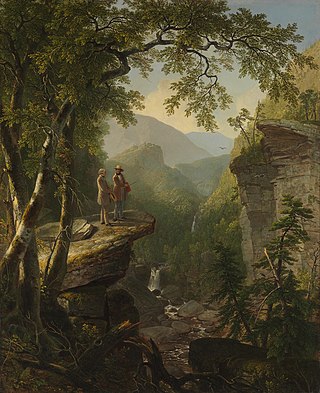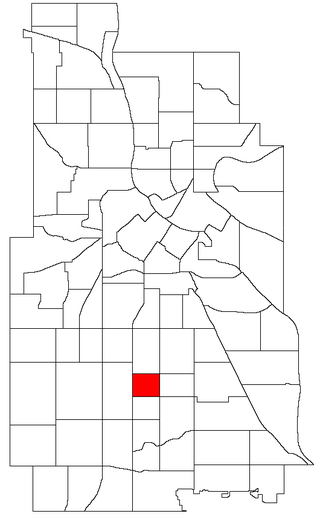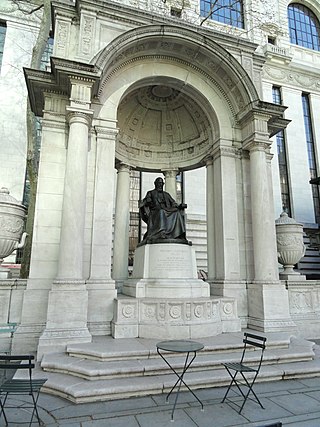
Cummington is a town in Hampshire County, Massachusetts, United States. The population was 829 at the 2020 census, a decline from the figure of 872 tabulated in 2010. It is part of the Springfield, Massachusetts Metropolitan Statistical Area.

William Cullen Bryant was an American romantic poet, journalist, and long-time editor of the New York Evening Post. Born in Massachusetts, he started his career as a lawyer but showed an interest in poetry early in his life.
William, Willie, Bill or Billy Bryant may refer to:

"Thanatopsis" is an early poem by the American poet William Cullen Bryant. Meaning 'a consideration of death', the word is derived from the Greek 'thanatos' (death) and 'opsis'.

William Cullen Bryant High School, or William C. Bryant High School, and W.C. Bryant High School, or Bryant High School for short, is a secondary school in Queens, New York City, United States serving grades 9 through 12.

The William Cullen Bryant Homestead is the boyhood home and later summer residence of William Cullen Bryant (1794–1878), one of America's foremost poets and newspaper editors. The 155-acre (63 ha) estate is located at 205 Bryant Road in Cummington, Massachusetts, overlooks the Westfield River Valley and is currently operated by the non-profit Trustees of Reservations. It is open to the public on weekends in summer and early fall for tours with an admission fee.

Kindred Spirits (1849) is a painting by Asher Brown Durand, a member of the Hudson River School of painters. It depicts the painter Thomas Cole, who had died in 1848, and his friend, the poet William Cullen Bryant, in the Catskill Mountains. The landscape painting, which combines geographical features in Kaaterskill Clove and a minuscule depiction of Kaaterskill Falls, is not a literal depiction of American geography. Rather, it is an idealized memory of Cole's discovery of the region more than twenty years prior, his friendship with Bryant, and his ideas about American nature.
Nationality words link to articles with information on the nation's poetry or literature.

Bryant is a neighborhood within the Powderhorn community in Minneapolis, Minnesota, United States. Its boundaries are East 38th Street to the north, Chicago Avenue to the east, East 42nd Street to the south, and Interstate 35W to the west. It is entirely located within Minneapolis City Council Ward 8 represented by councilmember Andrea Jenkins, and Minnesota Senate District 62.
William Cullen Bryant was an American professional football player who was a running back and return specialist for 13 seasons in the National Football League (NFL) for the Los Angeles Rams and Seattle Seahawks. He played college football for the Colorado Buffaloes.
William Cullen (1710–1790) was a Scottish physician and chemist.

Cyrus Bryant was American educator and scientist and member of Academy of Natural Sciences in Philadelphia. He was brother of William Cullen Bryant and John Howard Bryant.
Cullen is a former hamlet in Benson Rural Municipality No. 35, Saskatchewan, Canada.
An embargo is the partial or complete prohibition of commerce and trade with a particular country.

Florinda is an oil-on-canvas painting by German painter and lithographer Franz Xaver Winterhalter. It was completed in 1853 and is now in the Metropolitan Museum of Art in New York, where it is not on display.

The William Cullen Bryant Memorial is an outdoor sculpture of William Cullen Bryant, located at Bryant Park in Manhattan, New York. The bronze statue was created by Herbert Adams and installed in 1911, the year the New York Public Library Main Branch building was completed.

An outdoor bronze bust of Giuseppe Mazzini by Giovanni Turini is installed in Central Park's Sheep Meadow, in Manhattan, New York. The sculpture was commissioned by a group of Italian-Americans and was dedicated in 1878 with a speech by American poet William Cullen Bryant. It sits on a granite pedestal, which includes two inscriptions that translate to "thought and action" and "God and the people". In 1994, the bust was restored by the Central Park Conservancy.

An outdoor bronze sculpture of Fitz-Greene Halleck by James Wilson Alexander MacDonald is installed in Central Park in Manhattan, New York. Commissioned by William Cullen Bryant and James Grant Wilson following Halleck's death in 1867, the statue was cast in 1876 and installed in 1877, becoming the first in Central Park depicting an American. An estimated 10,000 people attended its dedication on May 15, 1877.

Charity Bryant was an American business owner and writer. She was a diarist and wrote acrostic poetry. Because there is extensive documentation for the shared lives of Bryant and her partner Sylvia Drake, their diaries, letters and business papers have become an important part of the archive in documenting the history of same-sex couples.

Sylvia Drake was an American tailor and the long-term partner of Charity Bryant. The relationship between the two women was extensively documented through business papers, letters, and diary entries, and it has helped shed light on the realities of same-sex relationships in the nineteenth century.












